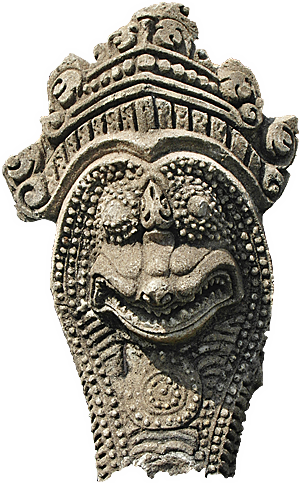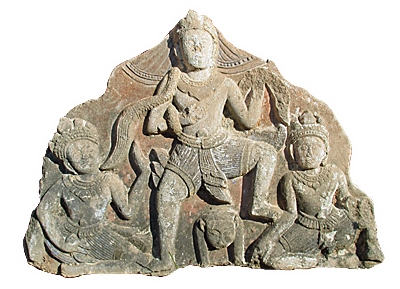
Phnom Chisor
Between Takeo (26km) and Phnom Penh (65km) another remarkable Angkorian temple site is situated. It's Phnom Chisor Temple. Originally called 'Sri Suriyaparvata' (the mountain of the Hindu sun god Surya) it was dedicated to Shiva and Vishnu. Phnom Chisor (Phnom = mountain) is 133m high.
The temple was erected in the reign of king Suryavarman I (reign: 1002/1010 - 1050 CE) and later extended. In Suryavarman's reign was also the Phimeanakas built, which is situated in what later became Angkor Thom. An upgrade of the famous Prasat Preah Vihear falls also in the time of Suryavarman I. The first half of the 11th century was coined by permanent unrest and the expansion of the Angkorian empire into nowadays Laos to the north and into nowadays Thailand to the west, including Lopburi.
Phnom Chisor, Main Front

The easter front of Phnom Chisor Temple with the main entrance. Image by Asienreisender, 11/2013
Photocomposition Phnom Chisor
The Angkorian Temple of Phnom Chisor
It seems that the Khmer sanctuary of Phnom Chisor at the time of it's construction marked temporarily the border of the Angkorian empire, which was in an expansive phase then.
Shiva
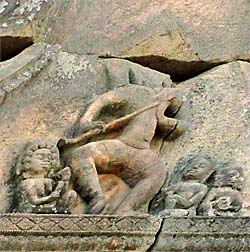
Shiva with a flute. Image by Asienreisender, 2015
The main entrance lead over the eastern stairway, which is almost no more in use nowadays; the tourist entrance is from the southern side. The first gate of entrance into the easter gallery is bedecked with a (broken) Shiva motive (1 and 4). Shiva is playing the flute; on the relief his head is now missing.
In medieval times the approach to the sanctuary by the high priests, the nobility or the king / royal family was from the direction of sunrise. More than a kilometer east of Phnom Chisor lies Tonle Om (3), one of the famous Angkorian barrays (water ponds). They were often of a huge size and part of a sophisticated canal and irrigation system. One of the very fascinating aspects of Angkor was the concept of a hydraulic city which allowed Angkor Thom to grow so big to inhabit up to a million people. That made Angkor Thom the biggest pre-modern city in world history. Here, at Phnom Chisor, the barray is neglected since long and is now, in the end of February and within dry season, a low-level lake, overgrown by reed and lotus flowers, declining into a swamp until rain starts again in around June.
Short west of Tonle Om Son Reveang (2) is placed, a first sanctuary which served ritual purposes. It migh have been a royal dressing room as well, where the king dressed in a for the following procession appropriate way. At the time (end of February 2015) Son Reveang is cleared of vegetation; in the central sanctuary is now a buddhist shrine.

On image 5 the whole procession road is to see, which stretched over more than a kilometer through the plain before arriving at Sen Thmol, another gate sanctuary directly at the foot of the mountain of Phnom Chisor. Probably the whole landscape looked different in the old times; certainly there were many people watching the spectacle and there was an infrastructure for them to stand, sit, kneel or prostrate when the procession went by. Royal life was coined by permanent rituals, everything was planned, nothing left to chance.
While image 5 shows the stairway from upstairs, 6 shows it from below with the easter gallery of Phnom Chisor Temple Compound on top of the mountain.
The carving of the two women riding on a bull (7 and 13) is on the gable above the inner gate of the easter gallery. There is a story coming with it that the woman left fell from a mango tree what caused an emergency birth.
The images 8 and 9 show the main sanctuary of Phnom Chisor Temple. The US air force dropped a big bomb on it in an air raid in 1973 which destroyed the roof but, fortunately, didn't explode. The old roof is till now replaced by a tin roof. The rear building of the main sanctuary (11) is housing a lot of idols, fetishes and accessoires of spiritual hocus pocus. A linga, a monk's statue, a Buddha statue in the rear, joss sticks and, above all and in front of all the other pieces, the stately donation box. A man who is to see sitting at the entrance (8) is permanently there and cares for the sanctuary and it's furnishings.
Inside the northern library is a tablet with a sanscrit inscription (12).
Click the chapter to access the photocomposition of Phnom Chisor Temple Compound.
All images and photocomposition by Asienreisender, 2015
The site consists of a central shrine, surrounded by five more shrines and two libraries. They all are inside a walled gallery with two entrance gates. As typical for the ancient Khmer buildings, the construction material is laterite, bricks and sandstone for the carvings.
Eastern Stairway
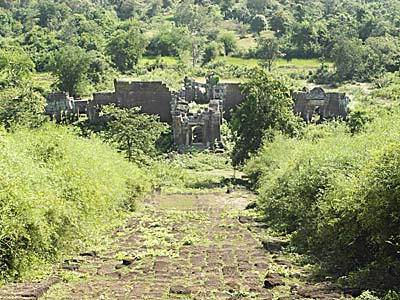
Sen Thmol, the gatehouse at the foot of the hill. It's very much overgrown by vegetation. Few people use this access to the site. Behind the building (not recognizable on the image) follows the old access road from Son Reveang. This was the main ceremonial access to the site when it was still in use. By the way: there is no entrance charged when accessing the sight from here. Image by Asienreisender, 11/2013
There is a number of lintels with carvings, inscriptions and ornaments to see. The whole site is not in a really well state, but some restorations have been done. In the times of ancient Angkor the site must have been of some significance for the empire.
The original approach to the site was on an east-west axis road. Some hundred meters east of the main site, on the plain, there is Son Reveang, the outermost gatehouse of the site, placed. Here is also a baray, an artificial lake, called Tonle Om. Following the old road, which is barely in use anymore and rather a jungle treck, one comes to a second ruined and inner gatehouse made of laterite stones. It's name is Sen Thmol, mostly overgrown now and not restorated. Directly west of it starts a wider laterite stairway which leads up to the top of the mountain and narrows later. It's less than 500 steps up to the main site, which is located on the easter part of the hilltop.
Lintel
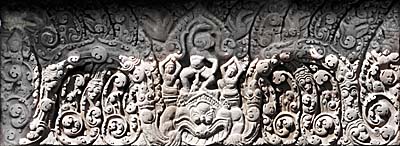
The (restored) lintel above the door of the northeaster sideshrine at Phnom Chisor. Image by Asienreisender, 11/2013
Keep in mind that this is not the tourist entrance and very few people approach from here. The main approach to the site is from the roadside, south of the site. Between the road, which leads to national road nr. 2 and the hillfoot are some food vendors. It's also kind of a parking when one is coming with an own vehicel. No doubt there will be someone coming and try to sell a ticket for the parking. Though, they have no legitimation to do that; it's just a self-made invention to cash from uninformed foreigners.
The stairway upwards from there is said amounts of 412 steps. At the top there is a cashpoint. A kind of a guard is demanding two dollars from foreigners.
At the northwest of the hilltop is a modern Buddhist temple placed.
The view over the surrounding Cambodian landscapes, mostly rice paddies, is praised by many visitors.
The site fell victim to an American air raid in 1973 and suffered heavy destruction.
Phnom Chisor, West Front
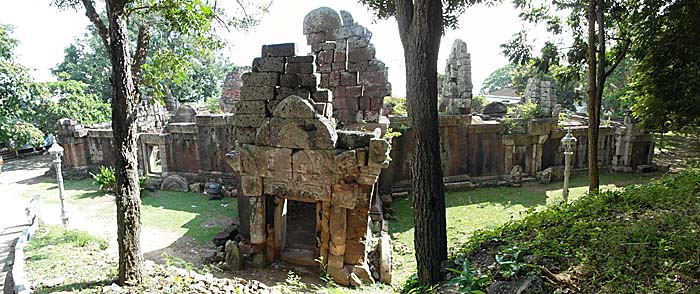
The west front of Phnom Chisor Temple. The image is a stitched patchwork and a bit distorted. Image by Asienreisender, 11/2013
Map of Phnom Chisor Temple Compound
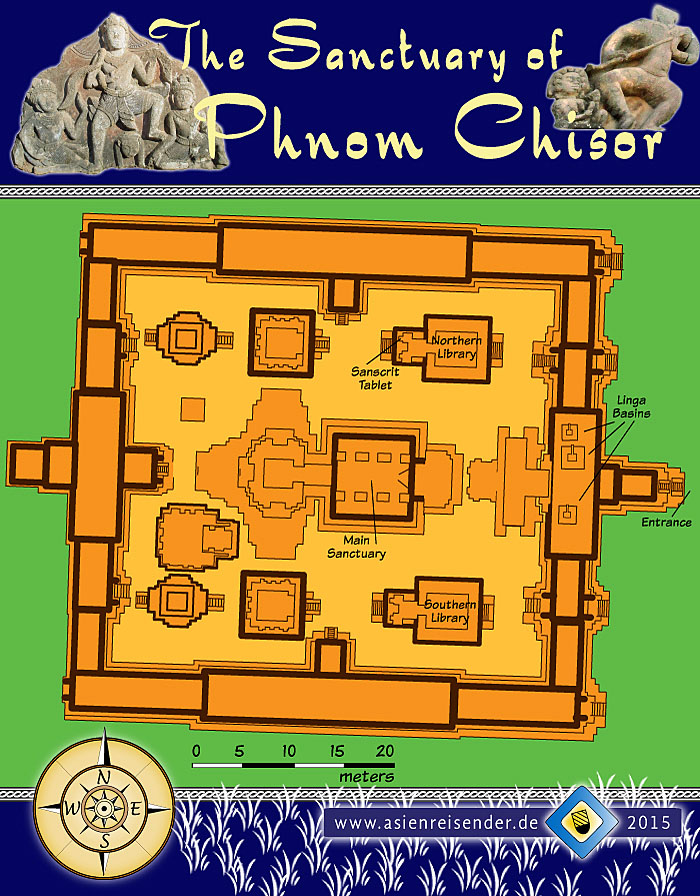
A remarkable difference between the temple on Phnom Chisor and other Angkorian temples is that here the inner court is so crammed with buildings, that it looks overloaded. There is little space for a walker to pass through the different monuments.
